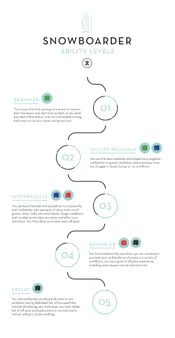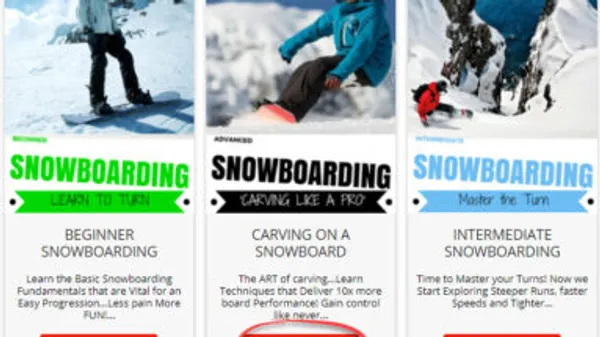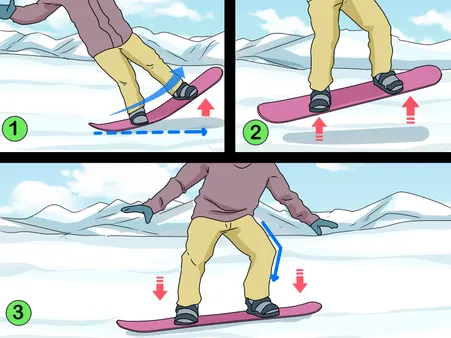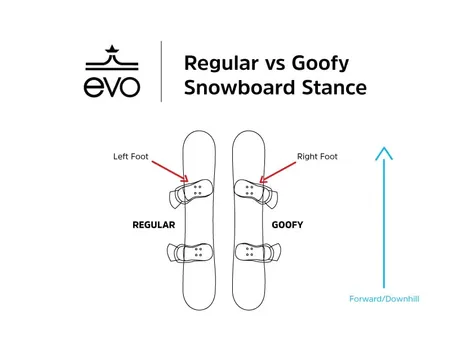Table of Contents
Embark on a thrilling snowboarding adventure with Kizworld, your trusted guide to mastering the slopes. Discover the fundamentals of snowboarding, from selecting the appropriate gear to executing basic maneuvers. Whether you're an absolute beginner or seeking to refine your skills, this comprehensive guide will equip you with the essential knowledge and techniques to navigate the snowy terrain with confidence and style.
How to learn the basic snowboarding skills and techniques
I. Mastering the Fundamentals of Snowboarding: A Comprehensive Guide to Basic Skills and Techniques
Mastering the Fundamentals of Snowboarding: A Comprehensive Guide to Basic Skills and Techniques
Essential Gear for Snowboarding: Ensuring a Safe and Enjoyable Experience
- Snowboard: Choose the right size and type of snowboard based on your skill level and riding style.
- Bindings: Ensure a secure and comfortable fit for optimal control and responsiveness.
- Boots: Select boots that provide support, warmth, and flexibility for all-day comfort.
- Helmet: Protect your head from potential impacts with a properly fitted helmet.
- Goggles: Shield your eyes from the sun, wind, and snow with high-quality goggles.
Stance and Balance: The Foundation of Snowboarding
Beginners should start with a neutral stance, with feet shoulder-width apart and knees slightly bent. As you progress, you can adjust your stance to suit your riding style and preferences. Maintaining balance is crucial for controlling your snowboard and preventing falls. Keep your weight centered over the board and avoid leaning too far forward or back.
Turning and Stopping: Navigating the Slopes with Confidence
To turn, apply pressure to the toe or heel edge of your snowboard, depending on the direction you want to go. The more pressure you apply, the tighter the turn will be. To stop, simply drag your toes or heels in the snow to create friction and slow down. You can also use the sides of your snowboard to perform a controlled stop.
Falling and Getting Up: Embracing the Learning Process
Falling is a natural part of learning to snowboard. When you fall, try to relax and roll with the impact to minimize injury. To get up, start by rolling onto your back. Then, use your hands and knees to push yourself up into a standing position. Don't be discouraged by falls; they are opportunities to learn and improve your technique.
Safety First: Avoiding Common Mistakes and Hazards
Always wear a helmet and other protective gear when snowboarding. Stay within your limits and avoid taking on terrain that is too challenging for your skill level. Be aware of other snowboarders and skiers on the slopes, and yield to those who have the right of way. Obey all posted signs and regulations, and never snowboard under the influence of alcohol or drugs.
Progressing Your Skills: Taking Your Snowboarding to the Next Level
As you become more comfortable with the basics, you can start to progress your skills by learning new techniques and tricks. This could include carving turns, jumping off small features, or riding switch (riding with your opposite foot forward). With practice and dedication, you can become a confident and skilled snowboarder, enjoying the thrill and beauty of the slopes.
Related Posts:
- How to Choose the Right Snowboard for Your Skill Level and Style
- The Benefits of Snowboarding for Fitness and Fun
- The Best Snowboarding Equipment and Accessories
II. Conquering the Slopes with Confidence: Essential Snowboarding Techniques
Conquering the Slopes with Confidence: Essential Snowboarding Techniques
Mastering the Basics: A Foundation for Success
Embark on your snowboarding journey with a solid foundation in basic techniques. Learn how to stand properly on your board, maintain balance, and control your speed. These fundamental skills will lay the groundwork for more advanced maneuvers.
- Stance: Find a comfortable stance with your feet shoulder-width apart and your knees slightly bent.
- Balance: Keep your weight evenly distributed between your front and back foot. Shift your weight forward to turn left and backward to turn right.
- Speed Control: Use your edges to control your speed. Dig your toes into the snow to slow down and your heels to accelerate.
Turning with Confidence: Carving and Edging
Mastering turns is essential for navigating the slopes with grace and control. Learn how to carve your turns, using your edges to create smooth, controlled arcs. Practice edging, which involves applying pressure to one edge of your board to change direction.
Technique | Description |
Carving | Use your edges to create smooth, controlled arcs. |
Edging | Apply pressure to one edge of your board to change direction. |
Skidding | Slide your board sideways to slow down or change direction. |
Conquering Obstacles: Jumps and Rails
Once you've mastered the basics, challenge yourself with obstacles like jumps and rails. Learn how to approach jumps safely, generate pop, and land smoothly. Practice sliding on rails, maintaining balance, and controlling your speed.
Safety First: Essential Gear and Precautions
Prioritize safety by wearing appropriate gear, including a helmet, goggles, and warm, waterproof clothing. Be aware of your surroundings, obey the rules of the mountain, and stay within your limits. Learn how to fall safely and avoid common snowboarding injuries.
- Helmet: Always wear a helmet to protect your head in case of a fall.
- Goggles: Protect your eyes from the sun, wind, and snow.
- Warm Clothing: Dress in layers to stay warm and dry.
- Snowboard: Choose a snowboard that suits your skill level and riding style.
- Bindings: Ensure your bindings are properly adjusted for a secure fit.
Continuous Improvement: Practice and Progression
Snowboarding is a skill that improves with practice. Dedicate time to regular practice sessions, focusing on specific techniques and gradually increasing the difficulty of the terrain you ride. Seek feedback from experienced snowboarders and consider taking lessons to accelerate your progress.
With dedication and practice, you'll conquer the slopes with confidence and experience the exhilarating freedom of snowboarding.
How to Choose the Right Snowboard for Your Skill Level and StyleThe Benefits of Snowboarding for Fitness and FunThe Best Snowboarding Equipment and Accessories
III. Navigating the Terrain: Tips for Handling Different Snow Conditions
Navigating the Terrain: Tips for Handling Different Snow Conditions
As you progress in your snowboarding journey, you'll encounter diverse snow conditions, each requiring a unique approach. Adapt your technique to harmoniously traverse various terrain.
Snow Condition | Tips |
|---|---|
Powder Snow | Glide effortlessly through the pillowy softness of powder snow. Maintain a centered stance, distribute your weight evenly, and make smooth, controlled turns.
|
Packed Snow | Encountering packed snow demands a more assertive stance. Increase your edge angle to maintain control and stability. Apply pressure to your front foot during turns for enhanced responsiveness.
|
Icy Snow | Icy patches require utmost caution. Reduce your speed, maintain a low center of gravity, and avoid sudden movements. Engage your edges firmly to maintain traction, but be gentle to prevent catching an edge.
Navigating rough terrain demands adaptability and finesse. Consult our comprehensive guide, "Mastering Snowboarding Techniques: A Beginner's Guide," for invaluable insights on tackling varied snow conditions. |
Regardless of the conditions, always prioritize safety. Wear appropriate gear, including a helmet, goggles, and protective clothing. Stay within your skill level and avoid taking unnecessary risks.
As your confidence and ise grow, you'll find immense joy in conquering different snow terrains. So, embrace the challenges, and keep pushing your limits while relishing the exhilarating experience of snowboarding.
IV. Safety First: Ensuring a Smooth and Enjoyable Snowboarding Experience
Safety First: Ensuring a Smooth and Enjoyable Snowboarding Experience
While snowboarding is an exhilarating sport, prioritizing safety is paramount. Embark on your snowy adventures with preparation and caution to create a memorable and enjoyable experience. Here are essential safety tips for snowboarding enthusiasts:
- Gear Up: Don appropriate protective gear, including a well-fitted helmet, goggles, and protective clothing. Prioritize quality to ensure maximum safety.
- Assess Conditions: Before hitting the slopes, take time to evaluate snow conditions and weather forecasts. Be prepared for changing circumstances and adjust your riding accordingly.
- Warm Up: Engage in dynamic stretches and light exercises to prepare your body for the physical demands of snowboarding. This helps prevent injuries and enhances performance.
Know Your Limits | Respect Others |
|---|---|
Recognize your skill level and choose slopes that align with your abilities. Gradually progress to more challenging terrains as you gain experience. | Adhere to snowboarding etiquette and share the slopes safely with fellow riders. Be mindful of others' space and speed to avoid collisions. |
Take Lessons: Consider enrolling in snowboarding lessons, especially if you're a beginner. Experienced instructors can provide valuable guidance, techniques, and safety tips to help you progress safely.
- Stay In Control: Maintain control of your speed and direction throughout your ride. Avoid reckless behavior that could endanger yourself or others.
- Obey Signage: Familiarize yourself with the signage and markings on the slopes. These signs communicate important information about trail difficulty, closures, and potential hazards.
Stay Hydrated: Pack water or a hydrating beverage to replenish fluids lost during your snowboarding session. Staying hydrated helps maintain focus and energy levels.
By following these safety guidelines, you can minimize risks and maximize your enjoyment while snowboarding. Prioritizing safety allows you to focus on the thrill and beauty of the sport, creating a memorable and fulfilling experience on the slopes.
Additionally, consider these tips for enhancing your snowboarding experience:
- Choose the Right Equipment: Select a snowboard and bindings that suit your skill level, riding style, and weight. Proper equipment can significantly improve your performance and safety.
- Practice Regularly: Consistent practice is key to improving your snowboarding skills and gaining confidence on the slopes. Dedicate time to regular riding sessions to refine your technique and progress.
With dedication, practice, and a commitment to safety, you can become a skilled and confident snowboarder, enjoying the exhilaration and freedom of gliding through the snowy landscapes.
V. Conclusion
With this comprehensive guide, you're now equipped with the fundamental skills and knowledge to begin your snowboarding journey. Remember, practice is key to mastering the art. As you step onto the slopes, embrace the challenges and thrills that await you. Before you know it, you'll be gliding down mountains with confidence, exhilaration, and a newfound love for the sport. The slopes are waiting, so seize the opportunity and experience the magic of snowboarding!